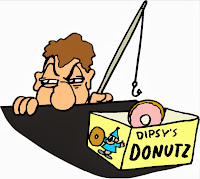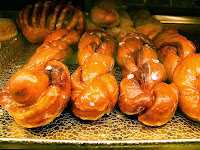Today is National Doughnut Day! Back in June we celebrated National Donut Day (pictured), which recognizes the "Donut Lassies"who worked for the Salvation Army during World War I handing out doughnuts to American soldiers in France.
On November 5 we celebrate the actual food (thus the word "dough"). The first donuts came from the Dutch, were called "oily cakes" and didn’t have a hole. They were fried in hot oil and the dough was sweet. Read more at
eatocracy.CNN.com
We've removed most sweet treats from our
Excel Math curriculum so we don't promote tooth decay or other not-so-great habits among students. However, doughnuts are still a favorite at AnsMar Publishers, Inc., where the curriculum is created (though we try not to indulge very often).

With
Excel Math, students
learn addition and subtraction plus foundational math concepts. Our
unique spiraling process helps students retain those concepts over the
long term. Learn more and take a look at
www.excelmath.com. You can also download our free Excel Math Placement Test for Kindergarten through Grade 6 to make sure your new students are starting at the optimal grade level. Grab a cup of coffee and a doughnut and surf on over to
www.excelmath.com for lots of great math resources.
To celebrate this yummy day of doughnuts, have your students make up word problems using doughnuts. Calculate how many dozen doughnuts you would need to have if you gave each person in the class one doughnut. (Don't forget the teacher!) If your students are learning to multiply using decimals, let them calculate the total cost if the doughnuts cost $3.50/dozen and they buy enough for the class and then find the cost per doughnut. Finally have the class calculate the total if the doughnuts cost $4.20/dozen. How much more would it cost to feed the whole class at the higher price?
This might be a good time to explain the concept of a "baker's dozen" or 13 doughnuts instead of 12. It was the practice of medieval English bakers to give thirteen rolls when twelve
were purchased, to protect themselves against accusations of the rolls weighing too little. The bread was sold by weight, not by number of pieces. Bakers could be flogged for selling bread that was under weight. So whenever they sold bread in any quantity, the bakers added something extra to make sure the total weight wasn't short. Read more about the baker's dozen at
www.phrases.org.uk.

If you'd like to try making your own doughnuts, an easy recipe is to start with canned refrigerator biscuits. Separate the biscuit dough. Cut a small hole in the middle of each piece of dough. Heat 1 - 2 inches of oil to medium high heat in a cast iron or heavy skillet. Drop in a doughnut hole to test. Turn it once using tongs and remove it when nicely browned. Drain it on a brown paper grocery bag.
Add several doughnuts and holes to the oil, brown, turn them and drain on a brown paper bag. Turn down the heat if the oil gets too hot. Then use the tongs to dip the warm donuts in powdered sugar or a mixture of cinnamon sugar. Let cool, then eat.
New to
Excel Math? Preview elementary math lessons that really work for Kindergarten through Sixth Grade on our website:
www.excelmath.com.
Download sample lessons from our new Common Core Teacher Editions for Grades 1-5 at
Do you have some favorite fall or food activities for teaching your students math concepts? Leave a comment in the box below. We love hearing from teachers, administrators and parents from around the country.
 The list could go on and on. Have the class share some of the words they would use to describe these people who are important to them. Let volunteers print some of these descriptor words on the board.
The list could go on and on. Have the class share some of the words they would use to describe these people who are important to them. Let volunteers print some of these descriptor words on the board. For a 3-D look, have your students cut out the small card patterns and stick them on the front or inside of the card backed with a piece of thick tape or glued to a small piece of sponge.
For a 3-D look, have your students cut out the small card patterns and stick them on the front or inside of the card backed with a piece of thick tape or glued to a small piece of sponge.























